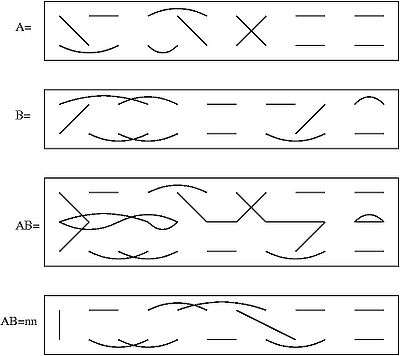Brauer algebra
In mathematics, a Brauer algebra is an algebra introduced by Richard Brauer (1937, section 5) used in the representation theory of the orthogonal group. It plays the same role that the symmetric group does for the representation theory of the general linear group in Schur–Weyl duality.
Definition

The Brauer algebra depends on the choice of a positive integer n and a number d (which in practice is often the dimension of the fundamental representation of an orthogonal group Od). The Brauer algebra has dimension (2n)!/2nn! = (2n − 1)(2n − 3) ··· 5·3·1 and has a basis consisting of all pairings on a set of 2n elements X1, ..., Xn, Y1, ..., Yn (that is, all perfect matchings of a complete graph K2n: any two of the 2n elements may be matched to each other, regardless of their symbols). The elements Xi are usually written in a row, with the elements Yi beneath them. The product of two basis elements A and B is obtained by first identifying the endpoints in the bottom row of A and the top row of B (Figure AB in the diagram), then deleting the endpoints in the middle row and joining endpoints in the remaining two rows if they are joined, directly or by a path, in AB (Figure AB=nn in the diagram).
The orthogonal group
If Od(R) is the orthogonal group acting on V = Rd, then the Brauer algebra has a natural action on the space of polynomials on Vn commuting with the action of the orthogonal group.
See also
- Birman–Wenzl algebra, a deformation of the Brauer algebra.
References
- Brauer, Richard (1937), "On Algebras Which are Connected with the Semisimple Continuous Groups", Annals of Mathematics, Second Series, Annals of Mathematics, 38 (4): 857–872, doi:10.2307/1968843, ISSN 0003-486X, JSTOR 1968843
- Wenzl, Hans (1988), "On the structure of Brauer's centralizer algebras", Annals of Mathematics. Second Series, 128 (1): 173–193, doi:10.2307/1971466, ISSN 0003-486X, JSTOR 1971466, MR 951511
- Weyl, Hermann (1946), The Classical Groups: Their Invariants and Representations, Princeton University Press, ISBN 978-0-691-05756-9, MR 0000255, retrieved 03/2007/26 Check date values in:
|access-date=(help)